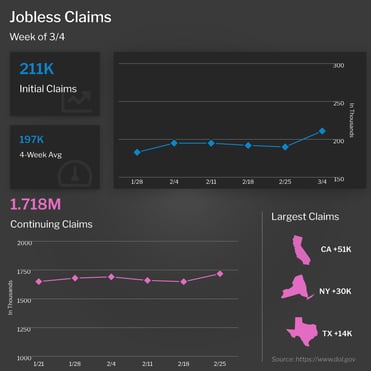Jobs, Home Prices and the Fed's Inflation Fight

A deeper look at labor sector data shows the job market may be weaker than the headlines suggest. Plus, the latest forecast on home price appreciation and the Fed’s vow regarding inflation:
- Jobs Data Shows Cracks in the Labor Sector
- Leisure and Hospitality Led the Way in Job Gains
- Continuing Jobless Claims Match 14-Month High
- Home Prices Still Forecasted to Appreciate This Year
- Fed Vows to “Stay the Course” in Inflation Fight
Jobs Data Shows Cracks in the Labor Sector
-png-2.png?width=371&height=278&name=bls-jobs-report%20(1)-png-2.png)
The Bureau of Labor Statistics (BLS) reported that there were 311,000 jobs created in February. While this was stronger than estimates, revisions to the data from December and January subtracted 34,000 jobs in those months combined. The unemployment rate rose from 3.4% to 3.6%.
What’s the bottom line? While the headline job growth number appeared strong, there were some cracks in the data.
There are two reports within the Jobs Report and there is a fundamental difference between them. The Business Survey is where the headline job number comes from, and it's based predominately on modeling and estimations. The Household Survey, where the Unemployment Rate comes from, is derived by calling households to see if they are employed.
The Household Survey has its own job creation component and it showed that there were only 177,000 new jobs created last month. The Household Survey also showed that the labor force increased by 419,000, which reflects more people entering the labor force and looking for employment. The number of people who have been unemployed for less than five weeks also jumped by 343,000, showing that people are having a harder time finding a job quickly after losing one.
Leisure and Hospitality Led the Way in Job Gains

Private payrolls were stronger than expected last month with 242,000 jobs created per ADP’s Employment Report, although seasonal adjustments did add to the strength of this reading. While wage growth remains elevated, it slowed for both job-stayers and job-changers. ADP noted that “a particular area of weakness is with small establishments, which shed jobs every month since August 2022.”
What’s the bottom line? The leisure and hospitality sector once again led the way with 83,000 job gains. But these gains may soon be coming to an end soon. During the height of the pandemic, roughly 10 million leisure and hospitality jobs were lost. With the recovery well underway, we have seen significant job growth in this sector and we’re now approaching pre-pandemic levels. This means leisure and hospitality job gains may not bolster the overall total for much longer.
Continuing Jobless Claims Match 14-Month High

Unemployment Claims rose in the latest week, as the number of first-time filers jumped by 21,000 to 211,000, which is the first time this metric topped 200,000 since early January. The number of people continuing to receive benefits after their initial claim is filed rose as well, surging 69,000 to 1.718 million and matching the highest reading in 14 months.
What’s the bottom line? Continuing Claims data clearly suggests it’s harder for people who are let go to find new employment. While this number can be volatile from week to week, the overall trend has been higher, as Continuing Claims have risen by 372,000 since the low reached last September.
This correlates with the Job Cuts Report from Challenger, Gray & Christmas showing that there were 78,000 job cuts last month, which is the highest February total since 2009. The report also noted that “so far this year, employers announced plans to cut 180,713 jobs … the highest January-February total since 2009.” While the bulk of cuts were in the technology sector, job cuts occurred in all industries Challenger tracks for the first time in a decade.
Home Prices Still Forecasted to Appreciate This Year
CoreLogic’s Home Price Index showed that home prices nationwide fell by 0.2% from December to January but they were 5.5% higher when compared to January of last year. This annual appreciation reading declined from 6.9% in December but is still solid. CoreLogic forecasts that home prices will drop 0.1% in February but rise 3.1% in the year going forward.
What’s the bottom line? CoreLogic’s Chief Economist Selma Hepp said that “the continued shortage of for-sale homes is likely to keep price declines modest, which are projected to top out at 3% peak to trough.” This is a far cry from a housing crash of 20% that some in the media have been predicting.
And while CoreLogic has reported slightly negative readings month to month, they still forecast 3.1% appreciation nationwide over the next year, which can be meaningful for wealth creation. For example, if someone bought a $400,000 home and put 10% down, they would gain $12,000 in appreciation over the next year and earn a 30% return on their investment due to leverage.
Fed Vows to “Stay the Course” in Inflation Fight
Fed Chair Jerome Powell presented the Fed’s Semiannual Monetary Policy Report to Congress. He said that although inflation has moderated in recent months, there is still a long way to go until inflation reaches the Fed’s 2% target – and the road “is likely to be bumpy.” Powell noted stronger than expected employment, consumer spending and manufacturing data suggested that inflationary pressures were running higher than expected. He vowed the Fed will “stay the course until the job is done.”
What’s the bottom line? The Fed has hiked its benchmark Fed Funds Rate eight times since last March, bringing it to a range of 4.5% to 4.75%. This is the interest rate for overnight borrowing for banks and it is not the same as mortgage rates. When the Fed hikes the Fed Funds Rate, they are trying to slow the economy and curb inflation.
The Fed is clearly afraid of inflation resurging like it did in the 1970’s, as Powell noted that “the historical record cautions strongly against prematurely loosening policy.” The Fed’s next meeting and decision regarding additional hikes to the Fed Funds Rate is March 21-22.
